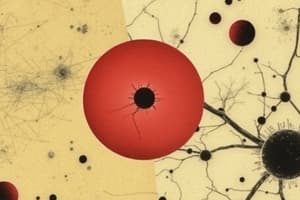Podcast
Questions and Answers
Match the following nitrogenous bases with their hydrogen bond partners:
Match the following nitrogenous bases with their hydrogen bond partners:
Adenine = Thymine or Uracil Cytosine = Guanine Guanine = Thymine or Uracil Thymine = Cytosine
Match the following components with their functions in the DNA molecule:
Match the following components with their functions in the DNA molecule:
Sugar molecule = Forms the backbone of DNA Phosphate molecule = Provides energy for DNA synthesis Nitrogenous base = Provides structural support to DNA Histone proteins = Influences gene expression
Match the following terms with their definitions:
Match the following terms with their definitions:
Chromatin = The network of chromosomes in the nucleus Chromosomes = The complex of DNA, RNA, and histone proteins Extranuclear DNA = DNA found in the mitochondria and chloroplasts Nucleotides = The building blocks of RNA
Match the following nitrogenous bases with their classification:
Match the following nitrogenous bases with their classification:
Match the following structures with their locations in a cell:
Match the following structures with their locations in a cell:
Match the following terms with their descriptions:
Match the following terms with their descriptions:
Match the following characteristics with the correct type of nitrogenous base:
Match the following characteristics with the correct type of nitrogenous base:
Match the following terms with their functions in the DNA double helix:
Match the following terms with their functions in the DNA double helix:
Match the following statements with the correct function of DNA:
Match the following statements with the correct function of DNA:
Match the following terms with their characteristics:
Match the following terms with their characteristics:
Match the following terms with their definitions:
Match the following terms with their definitions:
Match the following statements with the correct characteristic of DNA:
Match the following statements with the correct characteristic of DNA:
Match the following components with their roles in the genetic code:
Match the following components with their roles in the genetic code:
Match the following nitrogenous bases with their occurrence in DNA:
Match the following nitrogenous bases with their occurrence in DNA:
Match the following statements with the correct function of DNA replication:
Match the following statements with the correct function of DNA replication:
Match the following terms with their definitions:
Match the following terms with their definitions:
Flashcards are hidden until you start studying
Study Notes
Where is DNA Found?
- DNA is mainly found in the nucleus of a cell, forming part of the chromatin network.
- Small amounts of DNA are also found outside the nucleus in mitochondria and chloroplasts, known as extranuclear DNA.
Structure of DNA
- DNA is a long, twisted ladder-like molecule that forms a stable, 3-dimensional double helix.
- The DNA molecule is made up of nucleotides, which are building blocks consisting of a sugar molecule, a phosphate molecule, and a nitrogenous base.
Nucleotides
- There are four types of nitrogenous bases: adenine (A), thymine (T), guanine (G), and cytosine (C).
- These four bases are the foundation of the genetic code, instructing cells on how to synthesize enzymes and other proteins.
Double Helix Structure
- The outer two strands of the ladder are formed by a chain of alternating sugar and phosphate links.
- The rungs of the ladder are formed from pairs of bases linked by weak hydrogen bonds.
- The base pairs are attached to the sugar molecules.
Base Pairing
- Adenine (A) pairs with thymine (T) or uracil (U) using two hydrogen bonds.
- Cytosine (C) pairs with guanine (G) using three hydrogen bonds.
Classification of Nitrogenous Bases
- There are two groups of nitrogenous bases: purines and pyrimidines.
- Purines consist of two fused rings of nitrogen, carbon, and hydrogen atoms (e.g. guanine and adenine).
- Pyrimidines consist of one ring of similar atoms and are smaller than purines (e.g. cytosine and uracil).
Universality of DNA
- The four nucleotides are the same in all animals and plants.
Genetic Code
- The sequence of nucleotides determines the genetic code of an organism.
- The sequence of nucleotides in certain sections of DNA in a human is different from the same sections in every other human being (except in identical twins).
Role of DNA
- DNA molecules carry hereditary information in the form of genes.
- DNA provides a blueprint for an organism's growth and development by coding for protein synthesis.
- DNA can replicate, making a copy of itself to pass on genetic information to each daughter cell during cell division.
Non-Coding DNA
- Less than 2% of human DNA codes for proteins; the rest consists of non-coding DNA.
- Non-coding regions are interrupted by protein-coding regions called exons.
- Complex organisms contain more non-coding DNA than less complex organisms.
Studying That Suits You
Use AI to generate personalized quizzes and flashcards to suit your learning preferences.




